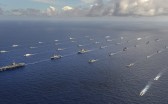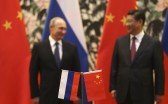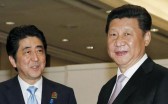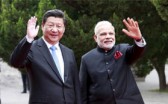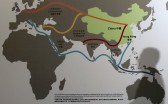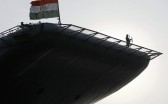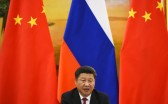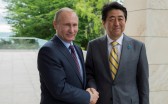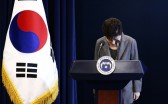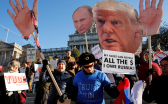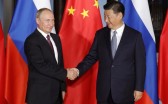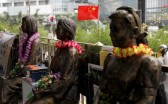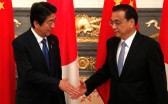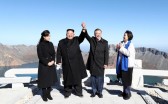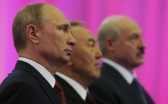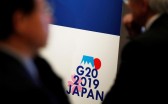Without getting into a quibble with Mr. Twinning’s analysis, parts of which I respectfully disagree with, allow me to use this opportunity to rather take a long view from New Delhi about what India’s foreign policy should be over the next decade. What are the levers that can enable and constraints that can hobble government from embracing these imperatives so that India’s larger strategic objectives can be a continuum as they were from the Vajpayee to the Manmohan Singh years, notwithstanding the vagaries of the electoral cycle?
The first and foremost question that needs to be answered: are there any medium-term strategic opportunities that India can or should leverage? Just two grand sweeps—one towards the east and the other towards the west—would suffice to respond to this query. As India looks toward the east, it does so from its perch at the head of the Indian Ocean straddling the sea lanes of communication and commerce as they crisscross from the geographical choke points of the Straits of Hormuz right up to the Malacca Straits. In the years to come, this location at the head of the Indian Ocean is going to become all the more germane as the China-Pakistan USD 46 billion economic corridor comes into play. This corridor of highways, railways, and pipelines primarily to transport oil and gas from the port of Gwadar in Baluchistan to the city of Kashgar in Xinjiang province is aimed at enabling China to surmount it’s “Malacca dilemma.”
This could and most certainly would lead to increased insistence by China in the South China Sea, as it would seek to action its trumpeted historical claims. It would make the littoral states of the South China Sea Indonesia, Malaysia, Vietnam, and the Philippines as well as Taiwan justifiably even more nervous than they are today.
There lies an opportunity to draw all these states into a loose coalition notwithstanding their individual economic linkages with China. For whatever the “One Belt, One Road” (OBOR) may be worth, all the minerals and other resources extracted by the Chinese through sweetheart deals in Africa and other parts of the world cannot go right up from Gwadar to Kashgar. Most of them would still have to traverse the Indian Ocean, Andaman Sea, and the Bay of Bengal. India’s airbase in Campbell Bay is just 240 kilometers from the mouth of the Malacca Straits. It is one of the levers that can come into play to counterbalance Chinese strategic posture in the South China Sea if it moves from bellicosity to aggression.
The net upside for India would be transforming the concept of the “Indo-Pacific” from an intangible construct into a strategic and economic reality. Coupled with the US presence in the Western Pacific and its hub and spoke security relationships all the way from Japan down to Australia, this coalition would be germane for keeping the global commons open and stable across the Indian and Pacific Oceans whose conjunction is the South China Sea. This can be achieved by India very much in terms of its own conception of the Asian power dynamic without looking at the Indo-Pacific region through the prism of the United States worldview.
This is where the Indo-Japanese relationship becomes vital. India has nurtured its relationship assiduously across changes of administration in both India and Japan. Prime Minister Abe’s recently concluded visit to India demonstrates this in ample measure. Not only was the trip significant for the “in-principle” closure of the agreed text of the Indo-Japan civil nuclear cooperation paradigm, but, more importantly, it signaled convergence of views on the strategic realities of the Asia-Pacific region, principally how to manage China’s growing profile that has manifested itself quite abrasively in the past ten years.
As an aside, it would perhaps be appropriate to mention that Abe was accorded the same respect and protocol whether he is in government or not whenever he has visited India. Back in 2011 when he visited New Delhi to explain how Japan was coping with the aftermath of the Fukishima disaster, Prime Minister Manmohan Singh extended him the same courtesy that would be due to an incumbent prime minister, hosting a private—almost intimate—lunch for where the author was also present. Thus, properly leveraged, Pakistan’s economic big-ticket opportunity can also be India’s windfall. This would be the perfect opportunity to “act east” rather than just keep looking east. Similarly with each of the states in the larger Asian region that share a common border with China, India needs to work closely to identify areas of convergence that can transform each bilateral interaction into a special if not strategic relationship.
As India turns its gaze towards the west, it discerns tectonic forces of religious chauvinism and terrifying ruthlessness bolting across the region erasing all territorial boundaries. The inane attempt to reorder the Middle East order that emerged from the ashes of the Ottoman Empire has miscarried miserably. However, in this mess lies another opportunity for India. As Al Qaeda, the Islamic State, the Taliban, and numerous other militant Islamists prepare for the final push from Turkey to Pakistan, the democracies of Europe and India should automatically be drawn into a closer embrace. Not only would closer security cooperation become an imperative as the Paris massacre has once again demonstrated, but, at a syncretic level also, India is perhaps the only country where for over a thousand years now Islamic influence has been absorbed into its culture without fundamentally allowing it to alter the social ethos.
The unique experience that India brings to the table is the interface between an aggressive Islam and Indian ethos of multiculturalism, which has held the field down the ages. The former, despite the sword, was not allowed by the latter to substantially alter either the demographics or even the cultural moorings of the subcontinent. It created through assimilation as opposed to a clash of civilizations an enlightened version of Indian Islam that has existed cheek to jowl with other religious narratives for hundreds of years now.
This is the unique experiment that Christen civilization on the western frontiers of the Islamic spread would have to factor into its sociological strategy to supplement its own tryouts with multiculturalism. This knowledge was one of the things that India offered to the United States after 9/11 as to how to find an honorable accommodation with Islam over the long run, but the binary mindset of Bush’s advisors failed to grasp it. Interestingly the unique nature of these nuances of intricate subtlety was well understood if not internalized by a National Democratic Alliance government led by Prime Minister Vajpayee. For Prime Minister Modi to grasp the significance of such institutional wisdom, he would first need to understand the Vajpayee governance style as well as the magnificent idea of India itself. The reason why Vajpayee is being held out as a standard bearer is, given the polarized nature of India’s polity, Modi would be loath to learn from his predecessor Singh, who not only inherited but vigorously pursued many of Vajpayee’s initiatives.
Otherwise, the challenge of reining in religious revivalism and terrorism emanating from it may continue to bedevil liberal democracies for quite a few centuries to come. The United States as the outside balancer of power in every continent, Russia another eminent military power that has chosen to become engaged in the internecine conflicts that are plaguing the Middle East again, Europe being at the receiving end of the chaos in the Middle East, and the state of Israel because of its unique geographical position, all have an existential stake in reigning in militant Islamism.
Thus, the foreign policy and the strategic choices India makes would be determined by its ability to manage relationships and trends that operate on parallel tracks. There are complementarities on some issues yet adversarial positions on other interests. Beyond the medium-term opportunities, Modi and his government have to understand that nations alone do not affect India’s interests. Non-state actors, rogue nations, and corporate interests impact India too. Is it time to keep both the formal and the back channels open to them? Examples are the Afghan Taliban or the Somali tribes that have elevated piracy to statecraft. Not in the same basket by any stretch but more central is the question of full diplomatic relations with Taiwan either within or outside the “One China policy.” Even on the question of rules of engagement on the internet where humungous tech companies have a position on issues like net neutrality, India would have to determine whether its interests are best served by the multi-stakeholder process or the traditional Westphalian template.
India, therefore, would have to develop its own version of “exceptionalism” to engage with the world as it consolidates internally. Therein lies the classical dilemma for the practitioners of realpolitik. Strategic opportunities do not interminably remain open, however, they are juxtaposed with the realities of the Indian state, the most conspicuous of which is the lack of institutional capacity to deal with the world and itself concurrently. The world that we live in is perpetually in motion where change is the only constant. Does the Modi government have the internal institutional structures and the intellectual capacity to be able to absorb and synthesize these different strains and weave them into an enlightened vision of India’s interests? The jury after the first 18 months in office remains out on that.
